Boeing T-43 Bobcat Video - Landing at California Capitol Airshow
|
|
Boeing T-43 Bobcat
T-43 Bobcat
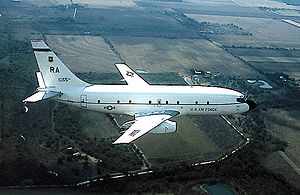
Role: Military training and transport aircraft
Manufacturer: Boeing
Introduced: September 1973
Retired: September 2010
Status: Active service
Primary user: United States Air Force
Number built: 19
Unit cost: $5,390,000
Developed from: Boeing 737
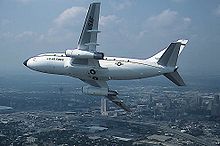
Picture - A T-43 in flight
The Boeing T-43 Bobcat was a modified Boeing 737-200 used by the United States Air Force. Informally referred to as the Gator (an abbreviation of "navigator"), nineteen of these aircraft were delivered during 1973 and 1974. The primary mission of the T-43 is as navigator training aircraft, although several were later converted to CT-43As as executive transports. The T-43 was retired in 2010 after 37 years of service.
Design and development
The T-43As were used for USAF Undergraduate Navigator/Combat Systems Officer training (with the exception of those USAF Navigators/CSOs slated for the F-15E and B-1B) and advanced interservice NAV pipeline training for Student Naval Flight Officers slated for eventual assignment to land-based naval aircraft. Externally, the T-43 differs from the civilian aircraft by having more antennae and fewer windows.
The T-43A has stations onboard for twelve navigator students, six navigator instructors, as well as a pilot and co-pilot. The student training compartment is equipped with avionics gear as used in contempary operational aircraft. This includes ground mapping radar; VOR (VHF omnirange) and TACAN (tactical air navigation) avionics systems; Long Range Navigation System (LORAN-C); inertial navigation system; radar altimeter; and all required VHF, UHF and HF communications equipment. Five periscopic sextant stations spaced along the length of the training compartment were used for celestial navigation training. However, with the advent of GPS, student navigators are no longer taught celestial navigation or LORAN.
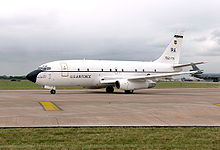
Picture - Boeing T-43A of the USAF 562nd Flying Training Squadron
The aircraft has considerably more training capability than the aircraft it replaced, the T-29B and T-29C. Introduction of the T-43 into Air Force Undergraduate Navigator Training (UNT) in 1974 also enabled the U.S. Navy to disestablish Training Squadron TWENTY-NINE (VT-29) and its T-29 aircraft at Naval Air Station Corpus Christi, Texas that had been training student Naval Flight Officers for various land-based naval aircraft such as the P-3 Orion, EP-3 Aries, and variants of the C-130 Hercules. The Navy then merged its NFO "NAV" pipeline with Air Force UNT in 1976, forming Interservice Undergraduate Navigator Training (IUNT) with both Navy students and instructors.
Inside each T-43A training compartment are two minimum proficiency, two maximum proficiency and 12 student navigator stations. Two stations form a console, and instructors can move their seats to the consoles and sit beside students for individual instruction. The large cabin allows easy access to seating and storage, yet reduces the distance between student stations and instructor positions.
The aircraft were initially assigned to the 323rd Flying Training Wing (323 FTW) of the Air Training Command (ATC) at Mather AFB, CA, plus two additional aircraft assigned to the Colorado Air National Guard to support introductory air navigation training for cadets at the United States Air Force Academy. When the 323 FTW was inactivated and Mather AFB closed by Base Realignment and Closure (BRAC) action in the early 1990s, most of the T-43s were transferred to the 12th Flying Training Wing (12 FTW) of the Air Education and Training Command (AETC) at Randolph AFB, TX, with the 12 FTW assuming the navigator training role.
Operational history
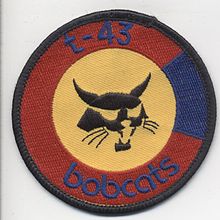
Picture - Colorado ANG T-43 "Bobcat" patch
Six aircraft of the nineteen originally ordered are still in service for the Air Force in their original role, based at Randolph Air Force Base, Texas and operated originally by the 558th Flying Training Squadron (558 FTS) and since 1996 by the 562d Flying Training Squadron and by the 563d Flying Training Squadron since 1999. The two additional aircraft used for introductory air navigation training of USAF Academy cadets continue to be operated by the Colorado Air National Guard at Buckley AFB and Peterson AFB, Colorado.
In addition, several T-43A were later modified to a transport aircraft configuration designated CT-43A, such as one previously operated by the 6th Air Mobility Wing (6 AMW) at MacDill AFB, Florida in support of United States Southern Command (USSOUTHCOM) for transport of the USSOUTHCOM Commander in Central and South America. Among these converted aircraft, one CT-43 crashed in Croatia in 1996 in a controlled flight into terrain (CFIT) mishap. The 6 AMW's CT-43A aircraft was replaced by a Gulfstream C-37A aircraft in early 2001.
On September 17, 2010 the final flight of the T-43 was flown at Randolph Air Force Base, and was subsequently retired from the active Air Force service after 37 years of service.
Variants
T-43A Model 737-253 powered by two JT8-D9 engines and provision for 3 instructors and 16 student navigators, 19 built. CT-43A T-43As converted as staff transports. NT-43A One T-43A (73-1155) converted as a radar test bed aircraft.
Operators
United States
United States Air Force
Accident
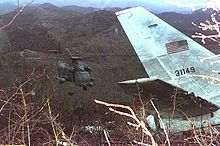
Picture - USAF MH-53J Pave Low helicopter near the wreckage of the USAF CT-43A in Croatia in 1996
On 3 April 1996, a CT-43A, USAF Serial No. 73-1149, carrying United States Secretary of Commerce Ron Brown and 34 other passengers and crew crashed in Croatia. There were no survivors.
Specifications (T-43A)
General characteristics
Crew: 2
Capacity: 23
Length: 100 ft (30.3 m)
Wingspan: 93 ft (28.2 m)
Height: 37 ft (11.2 m)
Wing area: 980 ft² (91.0 m²)
Empty weight: 64,090 lb (29,071 kg)
Loaded weight: 115,000 lb (53,300 kg)
Powerplant: 2x— Pratt & Whitney JT8D-9A turbofan, 14,500 lbf (64 kN) each
Performance
Maximum speed: 562 mph (904 km/h)
Range: 3,000 miles (4,830 km)
Service ceiling: 37,000 ft (11,200 m)
Related development
Boeing 737
Comparable aircraft
McDonnell Douglas C-9
Andrade, John (1979). U.S.Military Aircraft Designations and Serials since 1909. Midland Counties Publications. ISBN ISBN 0 904597 22 9.
Boeing T-43 Bobcat Pictures
Living Warbirds: The best warbirds DVD series.
Source: WikiPedia